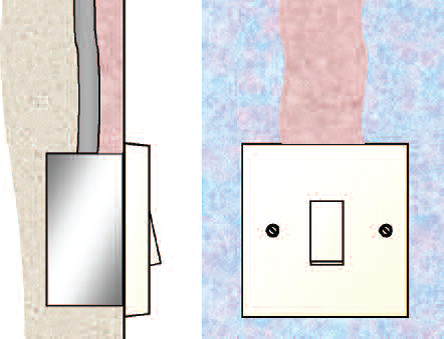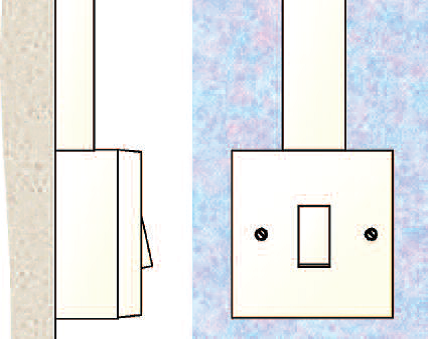Re-wiring and electrical upgrades
![]()
Since your property was built your electrics may have deteriorated and building regulations have changed so your electrical wiring may not meet current requirements.
Will I be notified when the work will be carried out to my property?
You will receive a letter from the Group to notify you that you are in this years’ programme and what work is required. The contractor carrying out the work will then contact you before work is due to start.
What happens next?
Our contractor will contact you to arrange a survey of your home and the work to be done, discuss the choices you have and answer your questions.
Important information:
If you have any special requirements or disabilities that you think need to be considered during the work, please tell the contractors. Please also tell them about any electrical items you have in any out-buildings, such as a freezer in your garage.
Who will be doing the work?
The Group employs specialist contractors to carry out its re-wiring programmes. The contracts usually span several years and all of the Group’s appointed contractors have many years experience working in the social sector.
How do I know that I’m giving access to the right people?
Whenever a contractor comes to your home, please ask them to produce their identity card.
Accessing your property
If you are out when the contractor calls round, they will leave a card with a phone number for you to call to arrange another appointment.
Electric tests and re-wires are compulsory due to health and safety. As part of your Tenancy Agreement you will need to give access for these.
Asbestos survey
Some properties may contain asbestos, so to comply with health and safety regulations we may need to do an asbestos survey before the work can be done.
If we already have this information about your property from previous work, a new survey will not be needed.
What do I need to do?
Before the rewire starts, the contractors will ask you to take down any pictures and pack away any fragile ornaments to protect them from accidental damage. Some furniture will also need to be moved, but you don’t need to do this until the work starts. The contractor will explain during the survey what will need to be moved. Often the contractors will need access to cupboards and loft spaces, so check this with them when the work is being arranged. This will give you time to clear these areas.
Please let us know about any special requirements you may have well in advance, so that we can plan the work better. This may simply be telling us your holiday dates, because we will need access to your home to do the work, but any helpful information you can give us means that we can more easily meet your needs.
During the work
On the day before the rewire the contractor may call to drop off material for the job. The work takes about one or two days. After the rewire, the property will be electrically tested and plastered. The contractor will collect all rubbish after the work is complete.
Pets
The work will be noisy and the contractors will need to access all areas of your home, including the front and back gardens.
Please ensure your pets are out of harm’s way and, if necessary, arrange for them to stay with friends or relatives during the work.
Covering and cleaning
The contractor will cover all your floors and furniture with dustsheets to protect them and to make it easier to clean up afterwards. After the rewire, the contractor will clean up any mess and put back any furniture they have moved.
Decoration
We will offer you a decoration voucher as a contribution towards the cost of re-decorating your home after the works. The voucher, which is valid for 28 days from receipt, is redeemable only at the supplier indicated on the voucher. The voucher will only be exchanged for decorating materials or tools, such as paint, wallpaper scrapers, /paint brushes, /rollers or brush cleaners.
Take care!
During the work the contractors will need to lift your floorboards, roll back carpets and run cables, all of which can be trip hazards.
Please take special care while the work is going on. We often recommend that tenants with mobility problems arrange to visit a neighbour or friend while this part of the work is being done.
What choices do I have?
Flush installation
A flush installation is the most common way of installing electrical cables. All cables are set into the wall and the switches and sockets only stand out a small way from the surface. There are two ways of doing this. The preferred way is to fix the new cables to the old ones and pull them up inside the wall. This causes minimal damage to decoration, but is not always possible.
Where this can’t be done, the contractor will need to chisel a groove into the wall for the cables to sit in. Once the cables have been fitted, the grooves will be plastered over. This method creates a lot of noise, dust and more damage to your decoration, but it gives the best finish.
Surface installation
A surface installation is used when a flush installation is not possible; this depends on the construction type of your property. Surface installation also minimises decoration damage. All cables are run in a plastic casing, called trunking, and attached to the wall. Sockets and switches are also fixed on the surface and housed in a box called a pattress.
If we can’t access floorboards or loft spaces, we use cornice trunking, which runs round the edge of the ceiling, allowing us to run our cables inside it.
 |
| Flush installation |
 |
| Surface installation |
How will I benefit from the rewire?
- In most cases you will have extra sockets fitted throughout the house, with low-level sockets fitted under your kitchen worktops for the washing machine and refrigerator.
- For your safety, we will install heat detectors, smoke detectors and, where required, a carbon monoxide detector.
- In the bathroom we will fit an enclosed fitting with a low-energy bulb, to comply with regulations.
- Outside your home, we will fit low-energy lights by the front and back doors. These lights have a sensor that turns them on automatically when it goes dark. This is an added security feature.
- We also replace any outdated fuse boards with a modern consumer unit. These offer quicker, more accurate protection if there is an electrical fault.
Who can I talk to if I have any questions?
Please call the contact number on your letter or ask for the Electrical Team on 01952 217100.
If you would like to give feedback, see the compliment and complaints page.